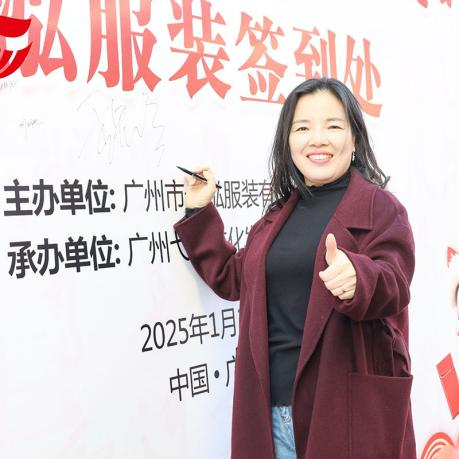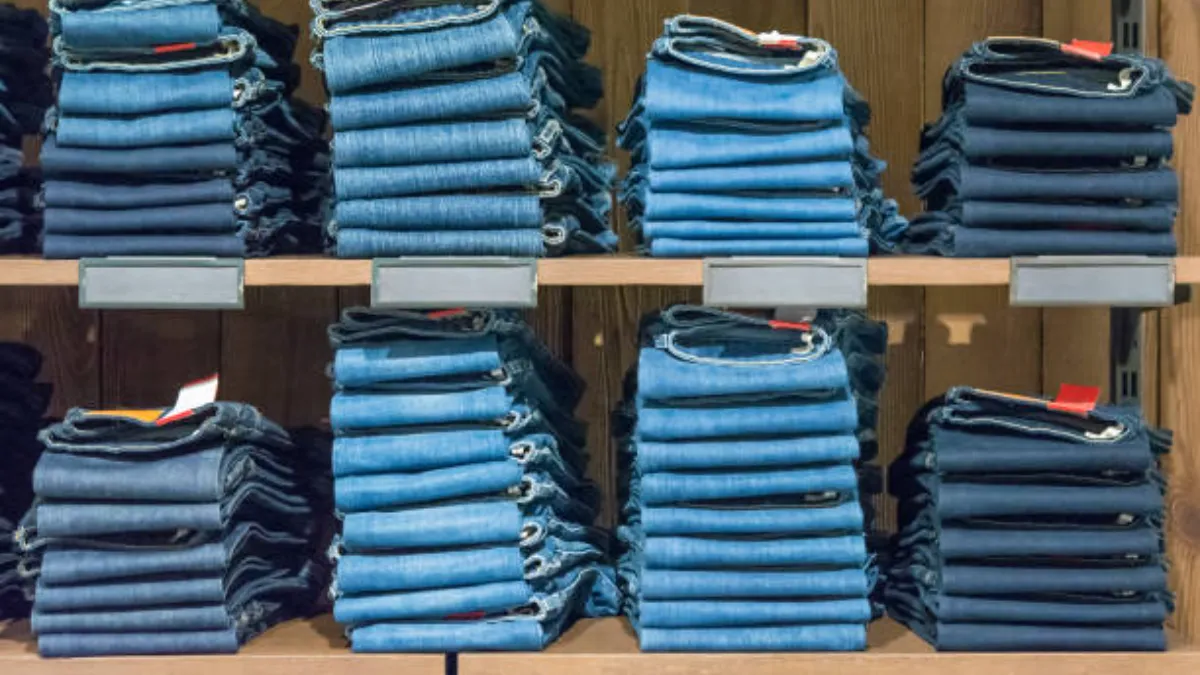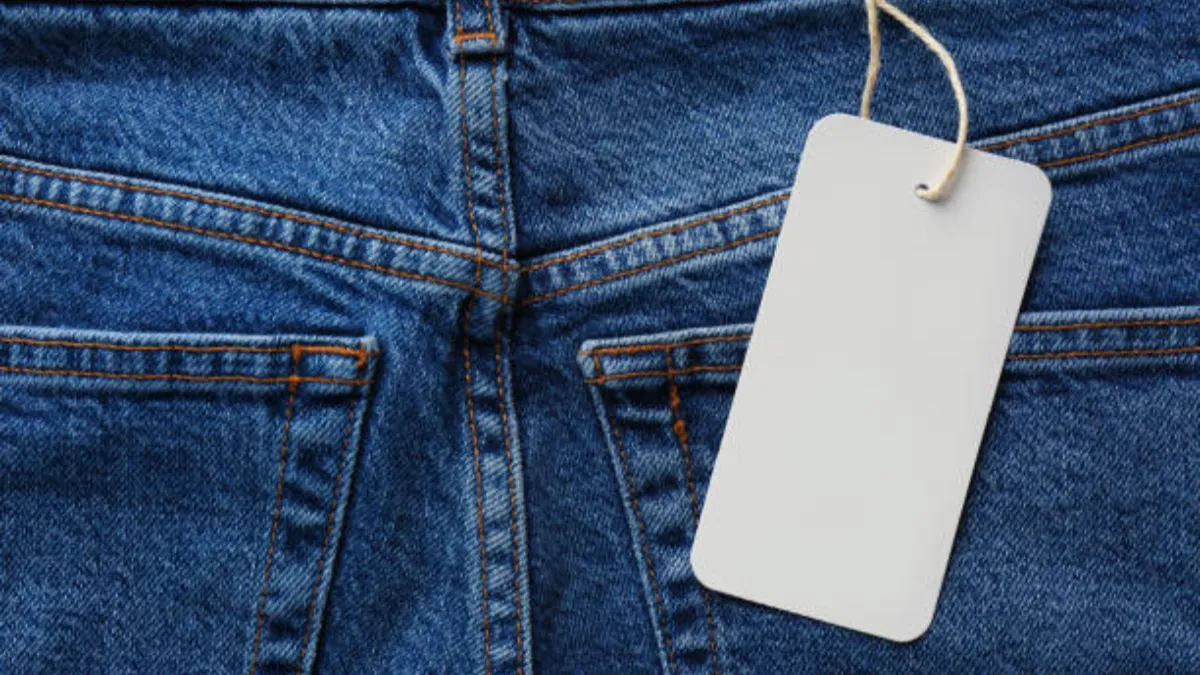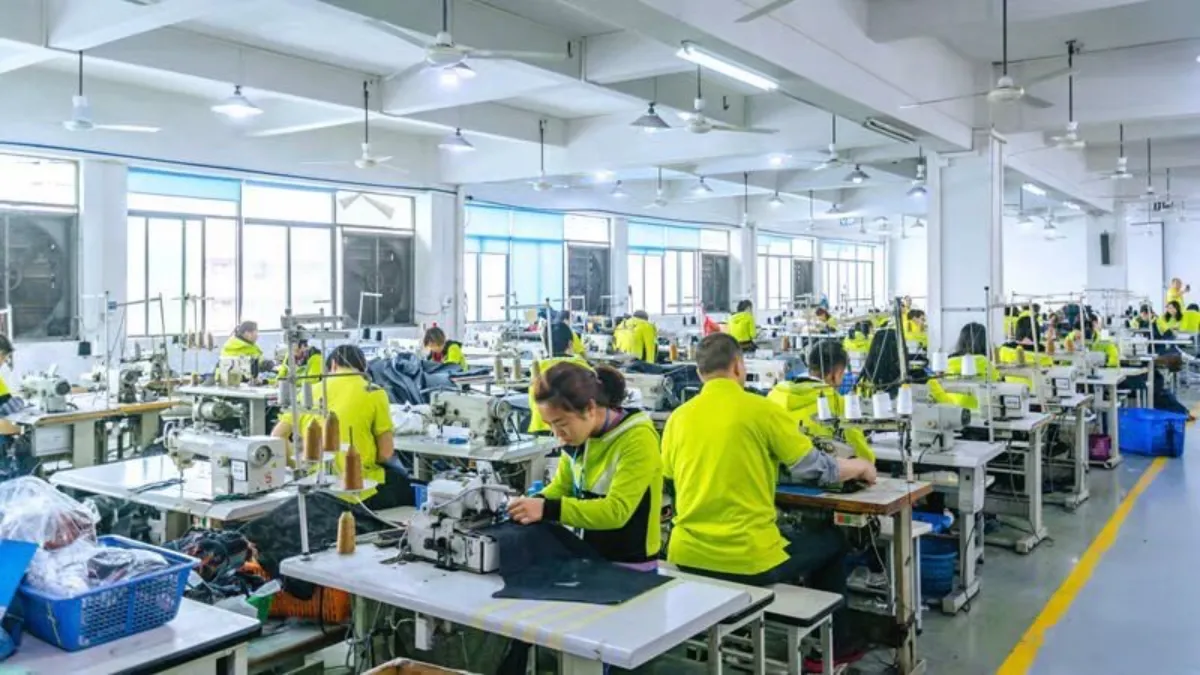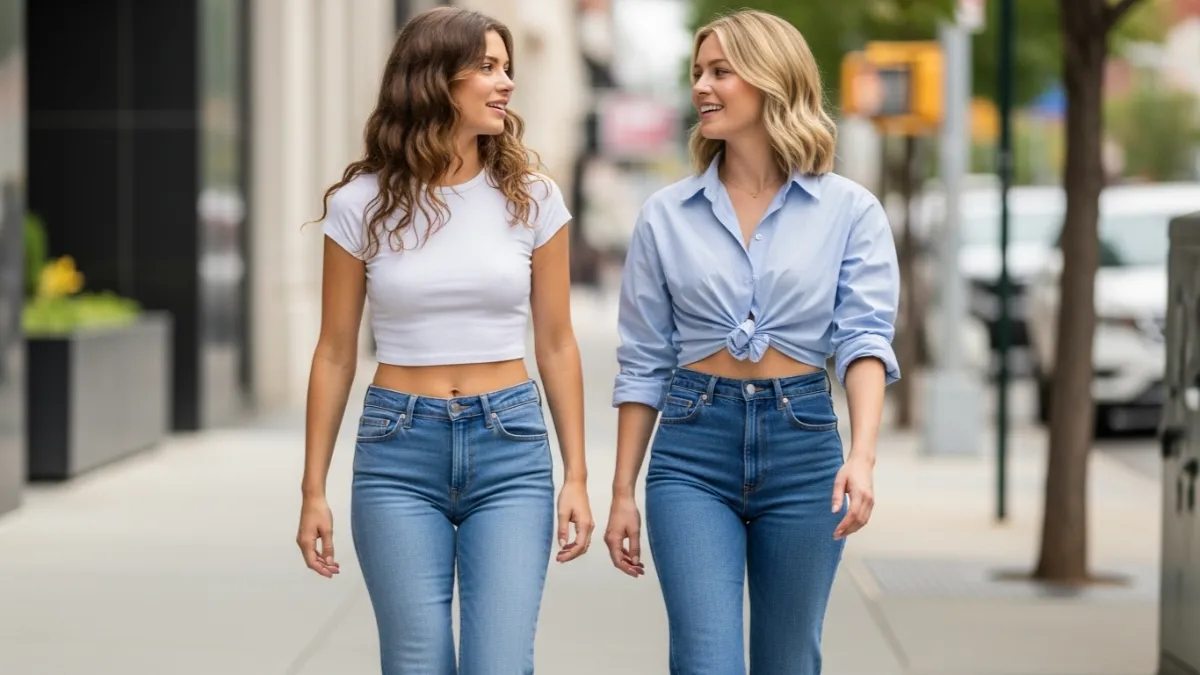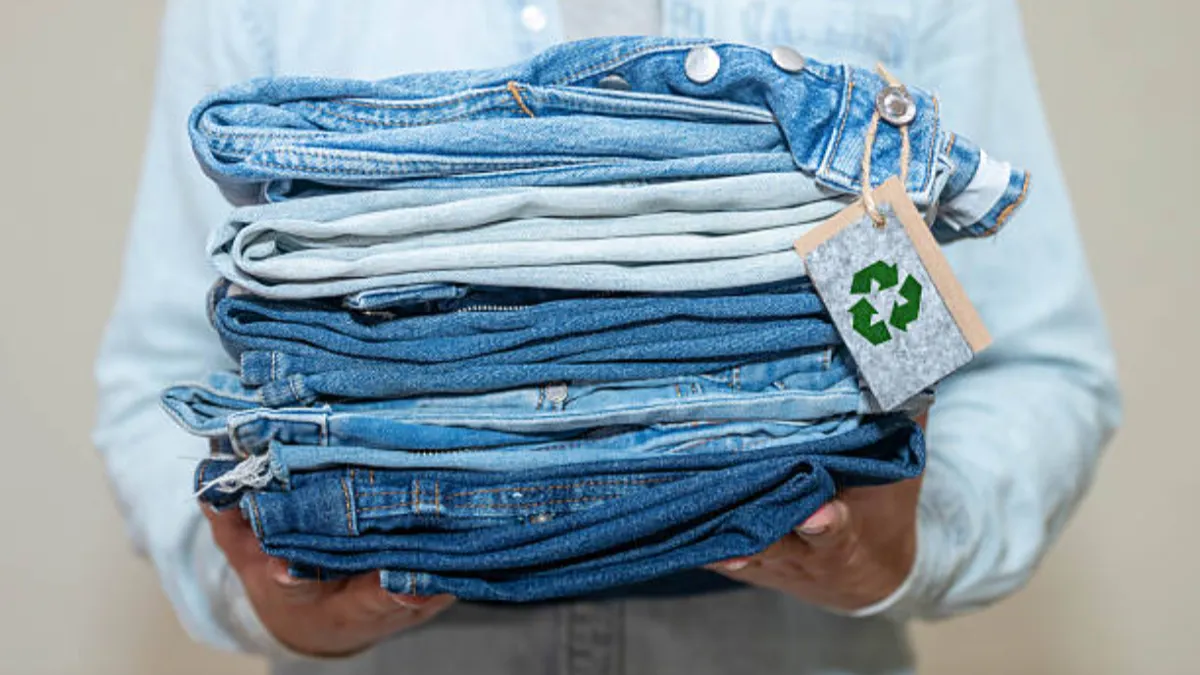Athleisure denim is redefining everyday fashion by blending the timeless appeal of jeans with the comfort and flexibility of performance wear. Manufacturing this fabric goes beyond fiber blending, which demands technical precision and attention to every detail. This guide walks you through each key step to help you craft durable, high-stretch denim that looks sharp and moves effortlessly with the wearer.
Prepare the Essential Tools and Materials
Before you start manufacturing stretch athleisure denim, you’ll need to gather all your essentials. Here’s what you need to set yourself up for success.
| Item | Especificações | Propósito |
|---|---|---|
| Cotton Fibers | High-quality premium cotton with consistent fiber length and strength | Provides the base fiber for denim strength, durabilidade, and that authentic denim feel your customers expect |
| Elastane Fibers | Lycra or Spandex with 95%+ stretch recovery rates | Delivers ultra-high stretch and recovery performance, ensuring the fabric bounces back after wear and maintains shape through thousands of cycles |
| Micro-Blending Machine | Advanced precision fiber blending system with homogeneous distribution capability | Ensures even elastane distribution throughout the cotton fibers, which is critical for consistent stretch across the entire fabric |
| Stretch-Optimized Loom | Specialized weaving equipment with tension control systems | Weaves knit denim while maintaining stretch integrity and preserving elastane functionality throughout the production process |
| heat setting Equipamento | Temperature-controlled setting tools with precise calibration | Stabilizes fabric dimensions and prevents shrinkage while preserving the elasticity that makes athleisure denim perform |
| Sewing Machines | Industrial machines specialized for stretch fabrics, equipped with ballpoint needles | Prevents fabric damage and skipped stitches when sewing stretch denim, ensuring clean seams that move with the fabric |
| Denim Washing Equipment | Industrial washers with multiple wash program options | Applies desired finishes like acid-wash, enzyme treatment, or softening while maintaining stretch performance and fabric integrity |
Etapa 1: Select and Blend Fibers for Stretch Denim

Your stretch denim journey starts with choosing the right fibers, and this decision sets the foundation for everything else. Begin with high-quality cotton as your base. That’s what gives your fabric that authentic denim character while keeping it soft, strong, and comfortable through countless wears.
Próximo, you’ll need to incorporate elastane fibers (that’s your Lycra or Spandex) at a ratio of at least 40% or higher. This isn’t just about stretch—it’s about achieving that ideal balance of flexibility and recovery that allows your denim to move effortlessly with the wearer and return to its original shape every time. Use advanced micro-blending technology to make sure the elastane is evenly distributed throughout the cotton base, ensuring consistent performance and durability from edge to edge.
Etapa 2: Weave and Knit for Flexibility and Strength
Once you’ve finalized your fiber blend, it’s time to bring those yarns to life through precise weaving or knitting. This is a stage that defines your denim’s flexibility, strength, and long-term performance. In this step, your goal is to use stretch-optimized weaving techniques that keep the elastane fibers fully functional. Since elastane is sensitive to tension, you’ll need to fine-tune your loom settings to protect its elasticity while maintaining a stable, compact weave.
If you apply too much tension, the elastane can lose its rebound before it even reaches your customer; too little, and you’ll end up with fabric that feels loose or unstable. Achieving that balance takes attention and experience, but it’s absolutely essential for producing high-quality stretch denim that moves beautifully and lasts through years of wear.
Consider knit denim fabrics if you’re targeting activewear with maximum stretch and comfort. Knit construction naturally offers:
- Higher stretch capacity than woven denim
- Enhanced flexibility for movement-intensive activities
- Superior recovery properties that maintain shape through repeated wear
- A softer hand feel that appeals to athleisure consumers
Knit denim gives you more freedom to push stretch ratios higher while maintaining fabric integrity, making it an ideal choice when your designs demand serious athletic performance.
Etapa 3: Apply Heat Setting and Finishing Washes
Heat setting and finishing are the final but essential stages before your stretch denim is ready for production. Heat setting uses controlled temperature to stabilize the fabric’s dimensions and secure the weave structure, preventing shrinkage or distortion after washing. Precision is key here—too much heat can weaken the elastane’s recovery, while too little won’t properly lock in the shape.
After heat setting, you’ll move into finishing washes. This is where aesthetics meet performance. You’ve got options here:
- Acid washes for that vintage, worn-in look
- Enzyme washes for a softer hand feel
- Stone washes for controlled distressing
- Bio-polishing for surface smoothness
But here’s what you can’t forget: every wash process you choose needs to preserve the fabric’s elasticity. If your finishing degrades the stretch or recovery rate, you’ve just wasted all the work you put into fiber selection and weaving. Always test your wash cycles on sample batches and measure the fabric’s extension and recovery before and after. That’s how you ensure your athleisure denim performs as well as it looks.d recovery before and after. That’s how you ensure your athleisure denim performs as good as it looks.
Soluções de jeans sob medida para sua marca
Partner with Changhong to access expert denim customization, from fabric selection to finishing touches. Our eco-friendly, low MOQ service supports your brand with over 20 years of industry experience and a seamless one-stop manufacturing process.
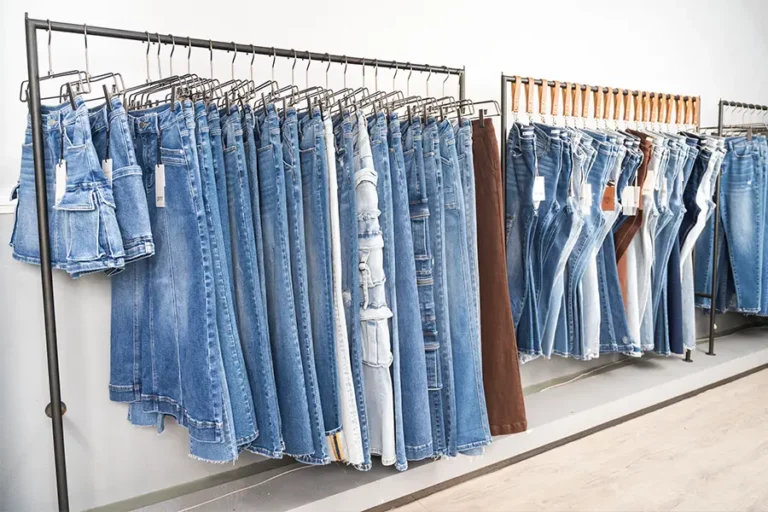
Etapa 4: Overcome Sewing and Pattern Challenges
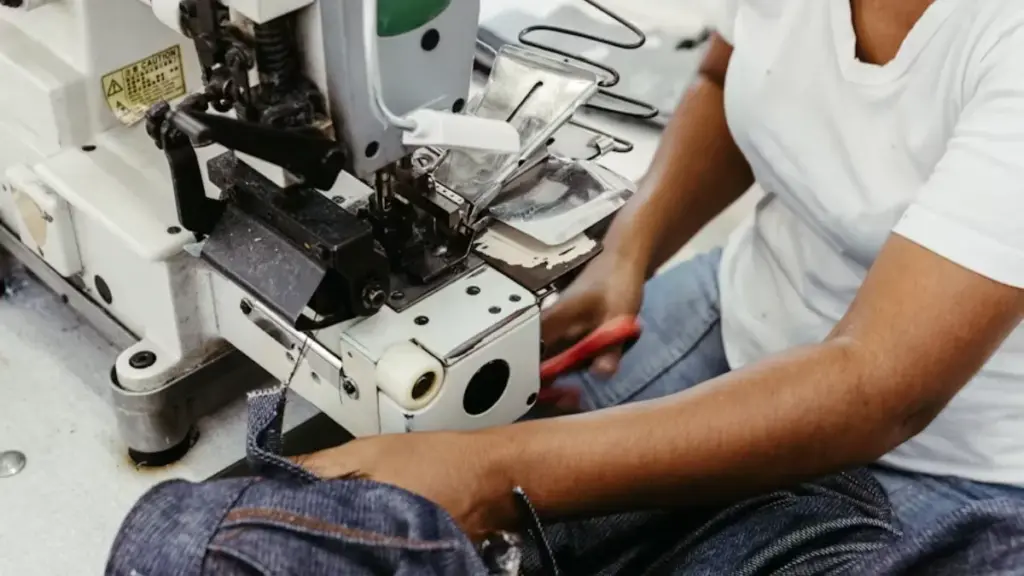
Working with stretch athleisure denim requires precision and care throughout production. Skipping the technical details here will lead to puckered seams, broken threads, and garments that lose shape after washing. Start by choosing the right tools. Regular sharp needles can pierce and damage elastane fibers, weakening stretch recovery. Instead, use ballpoint or stretch needles that slide smoothly between fibers. Pair them with polyester or poly-core threads that have built-in elasticity to withstand repeated movement and recovery cycles.
Standard rigid-denim patterns don’t work for stretch fabrics, which behave differently during construction and wear. So patterns must account for the fabric’s stretch percentage and reduced ease. Reinforce high-tension areas like knees, assento, and waistband with double stitching or strategic seam placement to prevent distortion.
Before full production, always run prototype tests—have wearers move, esticar, and sit to evaluate comfort and seam durability. Follow up with multiple wash tests to confirm shape retention and elasticity. This process ensures every piece of your athleisure denim line performs as well as it looks.
Etapa 5: Optimize Garment Construction for Movement
- Enhance mobility through functional design: Build flexibility into your garment by adding gussets at high-stress areas like the crotch or underarms. These inserts allow a wider range of motion and reduce tension lines, ensuring the fabric moves naturally with the body during activity.
- Shape for natural movement: Use articulated seams to pre-form knees and elbows, following the body’s natural contours. This technique prevents pulling or resistance during movement, making your denim comfortable and performance-ready for active wearers.
- Maintain structure with smart reinforcement: Balance stretch zones with reinforced stitching to preserve the garment’s shape. Apply elastic waistbands with firm bar tacks at stress points and choose flexible trims like soft rib knits or brushed elastic that stay comfortable during motion. This ensures every piece keeps its fit, function, and durability wash after wash.
Etapa 6: Maintain Quality with Global Standards and Sustainability

Maintaining quality starts with strict global standards like ISO 9001 and BSCI. These systems ensure consistent performance across every batch and show your commitment to reliability. Regular inspections, testing, and full process traceability help protect your brand and guarantee that each pair of athleisure denim delivers the same stretch, conforto, and durability your customers expect.
Sustainability now defines strong brands. Use organic or recycled cotton and eco-friendly finishing methods such as ozone or laser treatments to reduce water and chemical use. These methods keep the fabric strong and flexible while lowering environmental impact. When you pair green production with durability testing, you prove that your denim can last—and that your fabricação is truly responsible.
How to Avoid Common Mistakes?
Many brands run into the same issues when starting with stretch athleisure denim. A boa notícia? Once you know what to look out for, avoiding these mistakes is easier than you think.
| Erro comum | Solução / Como evitar |
|---|---|
| Using standard sewing machines causing skipped stitches | This happens because traditional machines can’t handle the elastane’s recovery rate. You need specialized equipment with ballpoint or stretch needles that glide between fibers instead of piercing them. Make sure your manufacturer uses machines designed for knit-like stretch fabrics. This prevents seam damage and ensures your garments maintain their integrity through thousands of wear cycles. |
| Applying traditional denim washes that degrade elastane | Standard stone washing and harsh chemical treatments can break down the elastane fibers, destroying the stretch performance you paid for. Insist on washes specifically formulated to preserve elasticity. Look for manufacturers who understand the 17-stage comfort engineering process and use heat setting optimization to stabilize fabric dimensions while maintaining stretch recovery rates above 95%. |
| Overstretching fabric during cutting and sewing | Stretch denim is forgiving, but it’s not indestructible. If you pull too hard during production, you’ll distort the fabric’s natural tension and end up with warped garments. Train your team to handle the material gently and maintain consistent tension throughout cutting and assembly. Use proper laying techniques and allow the fabric to relax before cutting patterns. |
| Ignoring low MOQ capabilities restricting small batch innovation | Many brands get locked into rigid production minimums that kill creativity and prevent testing new designs. Seek out manufacturing partners who offer flexible MOQs. This lets you experiment with different stretch ratios, fabric blends, and wash treatments without committing to massive inventory. Small batch production is your secret weapon for iterative innovation and responding quickly to market feedback. |
FAQs About Manufacturing Stretch Athleisure Denim
What is knit denim and how does it differ from woven denim?
Knit denim uses interlocking loops rather than interwoven threads, giving it natural stretch and a softer hand feel. Woven denim requires added elastane for stretch and offers more structure and durability for traditional jeans.
What is the maximum stretch percentage achievable in athleisure denim fabrics?
High-performance athleisure denim can achieve up to 95%+ stretch recovery rates when premium elastane fibers like Lycra or Spandex are precisely blended into the fabric. The actual extension capability depends on the elastane concentration and the sophistication of the micro-blending system used during manufacturing.
What are the main sewing challenges when working with ultra-stretch fabrics?
Ultra-stretch fabrics tend to curl at the edges and can distort under standard presser foot pressure. You’ll need specialized stretch needles, differential feed mechanisms, and careful tension management to prevent puckering and maintain the fabric’s recovery properties through the seams.
Can traditional acid-wash fades and finishes be applied to stretch denim?
Sim, but you need to adjust your process to protect the elastane fibers from degradation. The key is controlling the chemical concentration and exposure time so the cotton gets the desired fade while the stretch component maintains its extension capability and recovery performance.
What are the current market growth trends for stretch athleisure denim?
The athleisure denim category is experiencing strong growth as consumers prioritize comfort without sacrificing style. The 17-stage comfort engineering process and advanced tension management technologies are becoming industry standards, reflecting the market’s shift toward performance-driven fashion fabrics.
Crafting the Future of Stretch Athleisure Denim
Following these steps ensures you’ll produce high-quality, high-stretch athleisure denim that meets the demanding standards of today’s activewear market. Whether you’re launching a new line or refining an existing product, these insights will help you create durable, flexible denim that your customers will love.
No Changhong, we specialize in advanced denim manufacturing that blends innovation, sustentabilidade, and craftsmanship. With decades of experience, we help global brands produce high-stretch, eco-conscious denim that meets international quality standards.
Ready to bring your athleisure denim collection to life?
👉 Contact us today to explore custom manufacturing solutions designed for your brand’s success.

